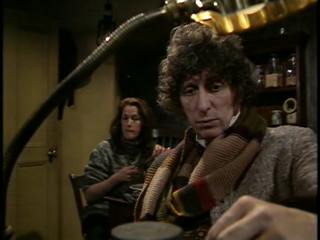 |
| "I have a bad feeling about this, Leela...it is as if a different, less competant person is controlling our adventures..." |
1) This is the first story of Graham Williams' tenure as the series' producer, and it'll prove to be a dark, dark time in the show's history. A lot of people give Williams a pass because his few highpoints are very, very high (The Key To Time), and because he got Douglas Adams to be script editor and to write a story or two. Since I think of Adams as a man with a very limited repertoire who showed more contempt for Who than affection, and The Key of Time hit and miss...well, I'm not all that impressed.
2) That being said--much like the last time we had a transition between producers, this story feels much more like a product of the previous administration. There's a definite Hinchcliffian Gothic feel to the story thanks to the atmospheric set designs and a clever script by Terence Dicks. In its way, this is the perfect melding between Hinchcliffe's very complex, very adult storytelling and Williams' much more simplistic, more child-oriented way of doing things.
3) The biggest indication of the sea change lies in Leela herself. It's a lot more subtle than it'll be in later serials, but there's a noticeable dumbing down of the character, as well as a general display of ignorance on her part. Louise Jameson does her best to deal with this schizophrenic revision, but it's obvious even when Dicks' script tries to create some continuity (the outburst where the Doctor defends her contention that there's been a drop in temperature is particular stands out) that she's not the person Philip Hinchcliffe intended her to be any more.
 |
| "So to review...you're greedy, you're honorable, you're a screamer, and you're inexperienced....got that, Leela?" |
4) While I appreciate that Dicks gives all of the supporting characters some time to define themselves, even inconsequential ones such as Ralph Watson's Ben and Annette Woollet's Adelaide, not all of them are worth it. Adelaide, in particular, is next to useless, being there mainly to sniff about Leela being a savage and screaming. A lot.
5) The weirdest thing about Leela is this story, incidentally, is how much I like her dressed in the slacks and cable-knit sweater she sports for the bulk of this story. The sweater takes away the rather silly leather tankini, which looks more bizarre in each new setting (but then, I'll learn to miss the original leather tankini when Williams introduces his new version later in the season), and seems to emphasize her viciousness. Heaven help me, here is the one time I find her sexy.
6) We should probably address the Rutan. Okay, I appreciate the (apparently spur-of-the-moment) choice to connect this monster to the Sontarans, the fact that it is...well, a giant dayglo green jellyfish with goofy shaky lines for eyes. The story does manage to conceal and obfuscate the appearance of the monster through shooting it through the foggy outsides of the lighthouse...but once it reveals itself to the Doctor on the steps in the fourth part, it's hard to take it seriously at all.
 |
| Evil Jello Molds are always a disappointment. |
7) ...especially given how gleefully creepy Colin Douglas is when the Rutan sneaks around disguised at Ruben. Not saying a word, his only reaction a wicked grin, Douglas' performance during this sequence is wonderful to watch. It makes up for some of the cliched elements of the character in the earlier parts of the story.
8) That whole last segment of the fourth page seems a bit...gratuitous, innit? I understand the need to repel the Rutan invasion fleet, but the whole 'we're going to convert the lighthouse into a laser weapon using Lord Grubby-Hands' diamonds he happens to keep on hand' development stinks of last minute improvisation designed to take up a few minutes and give Louise Jameson an excuse to ditch those uncomfortable contact lenses.
9) Given where Williams' tenure goes over his next couple of seasons, I have to give the story credit for continuing the fatalism and darkness of the Hinchcliffe era. Outside of The Doctor and Leela, no one really survives. Okay, some of that lack of survival was welcome--I'm looking at you, Adelaide the Screamer--but even the characters who behave in a heroic matter get their asses electrocuted. And this fatalism also leads to a scene where The Doctor admonished Leela for exulting in her killing the Rutan which is brief, but effective.
10) The very end may seem rather innocuous, with the Doctor quoting the poem that partially inspired this story...but this is just the first appearance of a lazy trope Williams uses again and again where he acknowledges his source material at the end. And trust me, it gets tired quickly.
Overall...a fairly good transitionary story that has within the seeds to why I do not care much for Graham Williams' tenure as producer. And while it gets much worse as we delve deeper into this dark time of Classic Who, this tale can be tentatively recommended.
No comments:
Post a Comment